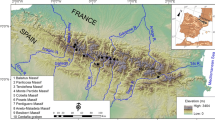Abstract
The European continent extends over a vast surface of ~ 10 million km2 from subtropical to polar latitudes. Most of the landmass corresponds to mainland Europe (including Great Britain), although a number of islands and archipelagos are also found surrounding the continent.
Access provided by Autonomous University of Puebla. Download chapter PDF
Similar content being viewed by others
The European continent extends over a vast surface of ~ 10 million km2 from subtropical to polar latitudes. Most of the landmass corresponds to mainland Europe (including Great Britain), although a number of islands and archipelagos are also found surrounding the continent.
Mainland Europe extends from latitudes 36 to 71ºN, and from longitudes 9ºW to 66ºE. The southern fringe is defined by the Mediterranean Sea and the northern edge by the Barents Sea. The western façade of the continent is washed by the waters of the Atlantic Ocean, whereas the eastern boundary is defined by the Ural Mountains (Fig. 1). In addition, there are several other islands and archipelagos surrounding Europe along its southern, western and northern fringes that have been affected by periglacial dynamics during the Quaternary or are still under cold-climate regimes with glacial and cryonival processes at almost sea level.
Despite the mid-low latitudes of Mediterranean islands (34–42ºN), most of them encompass extensive mountainous terrain with peaks above 2,400 (i.e. Corsica, Crete) to 3,300 m (i.e. Sicily), and several others exceeding 1,400 m (e.g. Sardinia, Cyprus, Kefalonia, Mallorca, etc.). In the North Atlantic Ocean Basin at latitudes of 32–38ºN, the volcanic islands of Açores and Madeira also include peaks ranging between 1,800 and 2,300 m that were affected by cold-climate processes during the Quaternary. Following the Mid-Atlantic Ridge, at higher latitudes (63–66ºN), Iceland is home of a wide range of periglacial processes and landforms, both active and relict, those inherited from previous cold periods. Other islands and archipelagos above the Arctic Circle that have a high percentage of their landmass covered by glaciers—such as Svalbard (~60%) and Jan Mayen (~30%)—or others that were formerly glaciated—such as the Faroe Islands and Bear Island – include abundant periglacial features in their ice-free landscape.
The configuration of the relief of mainland Europe is characterized by the numerous peninsulas, capes, bays and high mountain ranges exceeding 2,500–3,000 m, which has favoured the existence of a wide spectrum of climate regimes. Most of these ranges are located in the central-southern part of the continent, and form part of the Alpine-Himalayan orogenic belt, including the Pyrenees, the Alps or the Carpathians. The central-northern and eastern parts of the continental landmass are mostly characterized by a relatively flat terrain, with extensive flat areas only interrupted by mid-low mountain ranges (<1,500 m), occasionally exceeding 2,000 m in the Tatra Mountains or the Scandinavian Alps.
To the purposes of this book, we have examined the periglacial landscapes of Europe dividing the continent in three major regions following a latitudinal zonation:
-
Southern Europe: The southern fringe of the continent includes the Mediterranean peninsulas as well as several islands. The first section focuses on the westernmost peninsula that constitutes the SW corner of Europe, Iberia (Chapter 4). Subsequently, the next chapters are centred on the Italian Peninsula outside the Alps (Chapter 5) and the Balkan Peninsula (Chapter 6)—without the Carpathians—that are studied in a single chapter. The Anatolian Peninsula, including the different volcanoes and massifs existing in this large landmass, is also included in this section (Chapter 7). Finally, we also include a chapter focusing on the Mediterranean islands (Chapter 8), which include moderately high mountains where periglacial landscapes are also present.
-
Central and Eastern Europe: The Central part of Europe encompasses both mountain areas with current periglacial domain, as well as lowlands with traces of the past widespread periglacial conditions. The highest European mountains, the Alps (Chapter 9) represent the mountain area, where periglacial landforms and processes are extensively studied for more than a century. The summit areas of the Variscan ranges of Central Europe (Chapter 10) are also affected by current periglacial dynamics, however most of these mountains bear traces of the past more extensive periglacial realm. The Carpathians (Chapter 11) located in Central and Eastern Europe represent highly distinctive mountain belt strongly affected by north-south and west-east gradient in periglacial processes and associated landforms. The only lowland area representing the classical area of periglacial research, where past periglacial dynamics was extensively studied since the World War II, is the North European Plain (Chapter 12).
-
Northern Europe: The north-western quadrant of Europe, to the west of the North European Plain encompasses the Scandinavian Peninsula as the largest of the continent, and some islands from 50º to 80º N. This region includes both some of the oldest and youngest volcanic areas of the European continent, which in turn is reflected in a wide landscape variety. The first section starts at the southern part of this region, and is focused in the British Islands, including Great Britain and Ireland (Chapter 13). The following chapter go to the east, examining the periglacial dynamics and landscapes of Scandinavia (Chapter 14) covering a wide range of over 15º of latitude. And finally, this region is closed with the mid-oceanic Europe, i.e. Iceland (Chapter 15), an active area where the cold-climate processes associated to its location close to the Arctic Polar Circle interact with those linked to the volcanic activity, producing a unique landscape.
Author information
Authors and Affiliations
Corresponding author
Editor information
Editors and Affiliations
Rights and permissions
Copyright information
© 2022 The Author(s), under exclusive license to Springer Nature Switzerland AG
About this chapter
Cite this chapter
Oliva, M., Fernández-Fernández, J.M., Nývlt, D. (2022). Periglacial Landforms Across Europe. In: Oliva, M., Nývlt, D., Fernández-Fernández, J.M. (eds) Periglacial Landscapes of Europe. Springer, Cham. https://doi.org/10.1007/978-3-031-14895-8_3
Download citation
DOI: https://doi.org/10.1007/978-3-031-14895-8_3
Published:
Publisher Name: Springer, Cham
Print ISBN: 978-3-031-14894-1
Online ISBN: 978-3-031-14895-8
eBook Packages: Earth and Environmental ScienceEarth and Environmental Science (R0)





